This was purpose built in 1937 as the Regal cinema. It was then the most up-to-date cinema in Cambridge, a veritable ‘palace’ – as it was dubbed by cinema-goers of the 1930s. Until recently, it had been in use as the ABC cinema.
Photographs and text about The Regal.
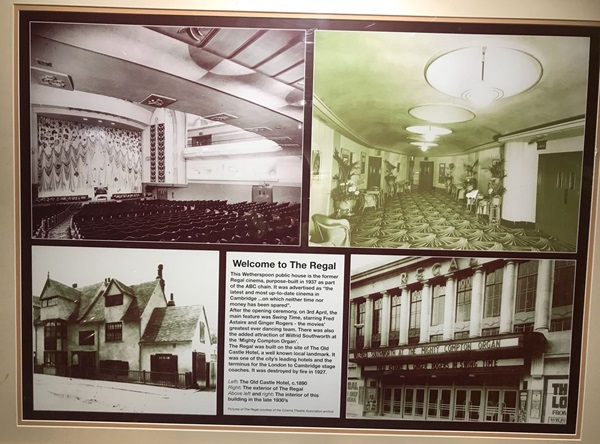
The text reads: This Wetherspoon public house is the former Regal cinema, purpose-built in 1937 as part of the ABC chain. It was advertised as “the latest and most up-to-date cinema in Cambridge… on which neither time nor money has been spared”.
After the opening ceremony, on 3 April, the main feature was Swing Time, starring Fred Astaire and Ginger Rogers – the movies’ greatest ever dancing team. There was also the added attraction of Wilfrid Southworth at the ‘Mighty Compton Organ’.
The Regal was built on the site of The Old Castle Hotel, a well-known local landmark. It was one of the city’s leading hotels and the terminus for the London to Cambridge stage coaches. It was destroyed by fire in 1927.
Left: The Old Castle Hotel, c1890
Right: The exterior of The Regal
Above left and right: The interior of this building in the late 1930s.
Photographs and text about the discoveries that changed the world.
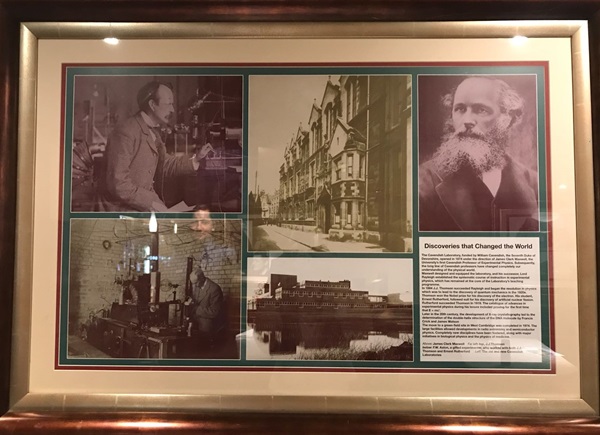
The text reads: The Cavendish Laboratory, funded by William Cavendish, the Seventh Duke of Devonshire, opened in 1874 under the direction of James Clerk Maxwell, the University’s first Cavendish professors have changed completely our understanding of the physical world.
Maxwell designed and equipped the laboratory, and his successor, Lord Rayleigh established the systematic course of instruction in experimental physics, which has remained at the core of the Laboratory’s teaching programme.
In 1884 JJ Thompson succeeded Rayleigh and began the revolution in physics which was to lead to the discovery of quantum mechanics in the 1920s. Thomson won the Nobel Prize for his discovery of the electron. His student, Ernest Rutherford, followed suit for his discovery of artificial nuclear fission. Rutherford succeeded Thomson in 1919. The catalogue of advances in experimental physics during his tenure included proving for the first time that E=mc2.
Later in the 20th century, the development of x-ray crystallography led to the determination of the double-helix structure of the DNA molecule by Francis Crick and James Watson.
The move to a green field site in West Cambridge was completed in 1974. The large facilities allowed developments in radio astronomy and semiconductor physics. Completely new disciplines have been fostered, along with major initiatives in biological physics and the physics of medicine.
Above: James Clerk Maxwell
Far left: top, JJ Thomson
Below: FW Aston, a gifted experimenter, who worked with both JJ Thomson and Ernest Rutherford
Left: The old and new Cavendish Laboratories.
Photographs and text about Ernest Rutherford.
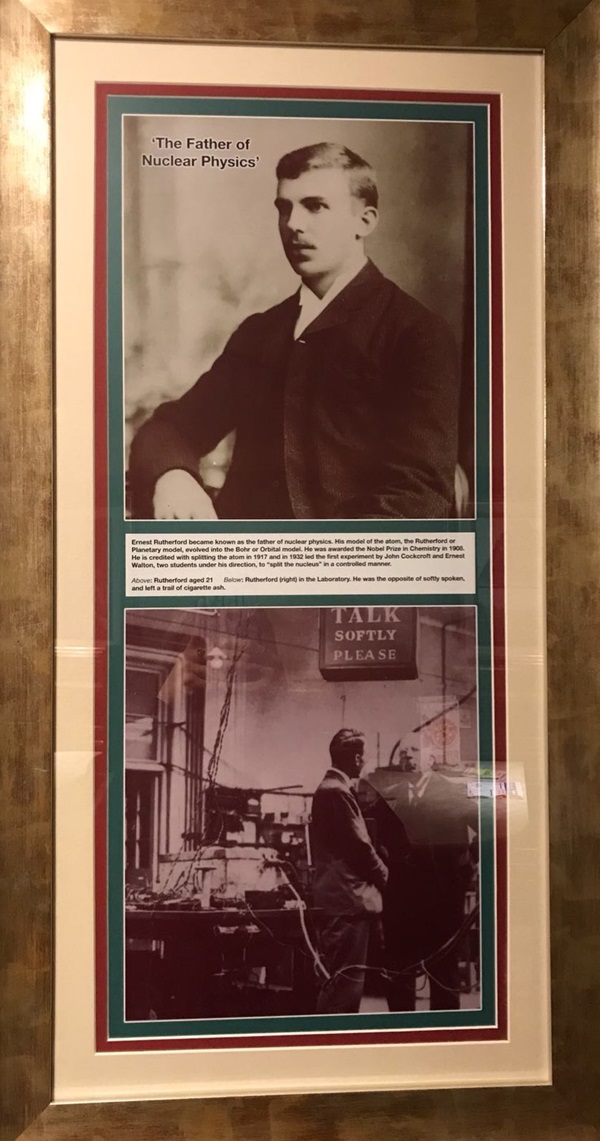
The text reads: Ernest Rutherford became known as the feather of nuclear physics. His model of the atom, the Rutherford or Planetary model, evolved into the Bohr or Orbital model. He was awarded the Nobel Prize in Chemistry in 1908. He is credited with splitting the atom in 1917 and in 1932 led the first experiment by John Cockcroft and Ernest Walton, two students under his direction to “split the nucleus” in a controlled manner.
Above: Rutherford aged 21
Below: Rutherford (right) in the Laboratory. He was the opposite of softly spoken and left a trail of cigarette ash.
Prints and text about David Gilmour.
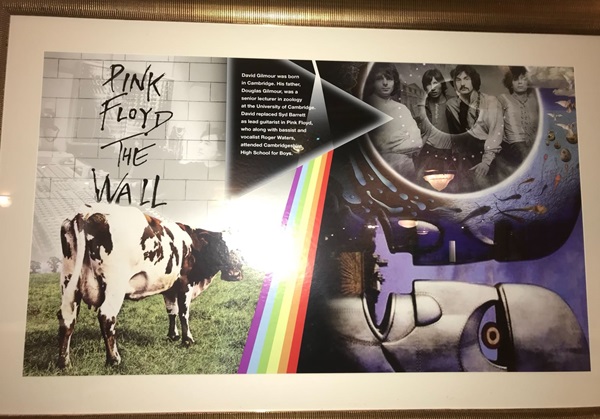
The text reads: David Gilmour was born in Cambridge. His father, Douglas Gilmore, was a senior lecturer in zoology at the University of Cambridge. David replaced Syd Barrett as lead guitarist in Pink Floyd, who along with bassist and vocalist Roger Waters, attended Cambridgeshire High School for Boys.
A photograph and text about the New Theatre.
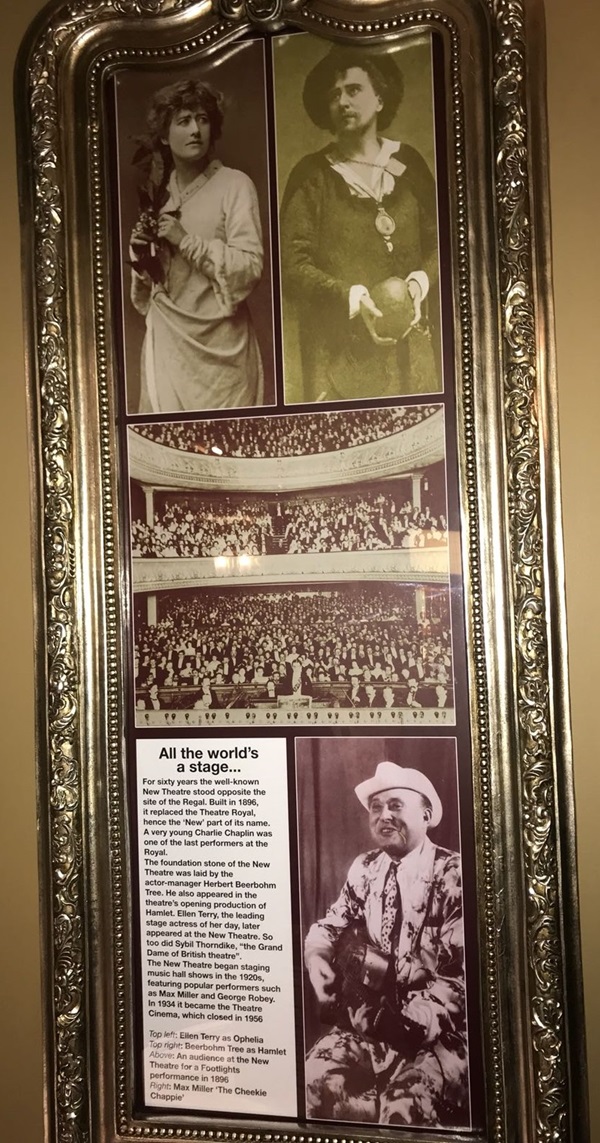
The text reads: For sixty years the well-known New Theatre stood opposite the site of the Regal. Built in 1896, it replaced the Theatre Royal, hence the ‘New’ part of its name. A very young Charlie Chaplin was one of the last performers at the Royal.
The foundation stone of the New Theatre was laid by the actor-manager Herbert Beerbohm Tree. He also appeared in the theatre’s opening production of Hamlet. Ellen Terry, the leading stage actress of her day, later appeared at the New Theatre. So did Sybil Thorndike, “the Grand Dame of British theatre”.
The New Theatre began staging music hall shows in the 1920s, featuring popular performers such as Max Miller and George Robey. In 1934 it became the Theatre Cinema, which closed in 1956.
Top left: Ellen Terry as Ophelia
Top right: Beerbohm Tree as Hamlet
Above: An audience as the New Theatre for a Footlights performance in 1896
Right: Max Miller ‘The Cheekie Chappie’.
Photographs, illustrations and text about Emmanuel College.
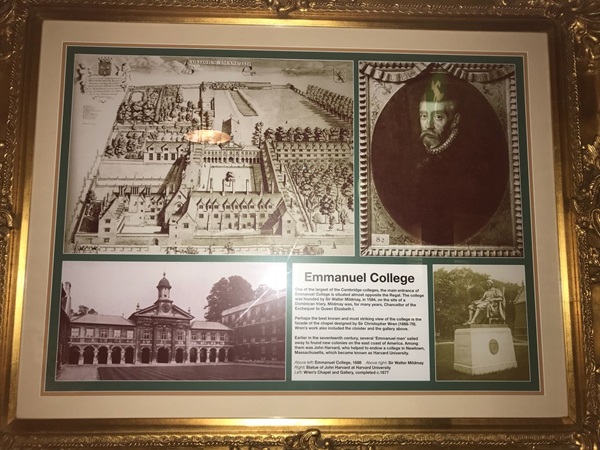
The text reads: One of the largest of the Cambridge colleges, the main entrance of Emmanuel College is situated almost opposite the Regal. The college Dominican friary. Mildmay was, for many years, Chancellor of the Exchequer to Queen Elizabeth I.
Perhaps the best known and most striking view of the college is the façade of the chapel designed by Sir Christopher Wren (1666-79). Wren’s work also included the cloister and the gallery above.
Earlier in the seventeenth century, several ‘Emmanuel men’ sailed away to found new colonies on the east coast of America. Among them was John Havard, who helped to endow a college in Newtown, Massachusetts, which became known as Harvard University.
Above left: Emmanuel College, 1688
Above right: Sir Walter Mildmay
Right: Statue of John Harvard at Harvard University
Left: Wren’s Chapel and Gallery, completed c1677.
Prints and text about Cambridge spies.
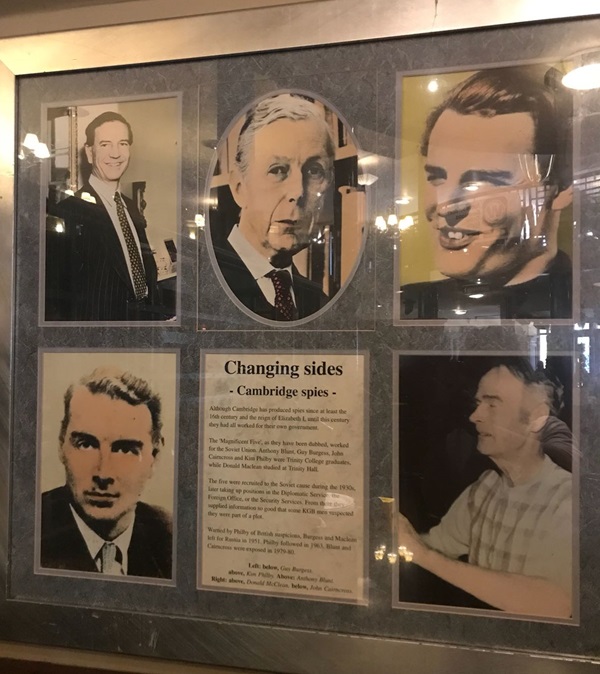
The text reads: Although Cambridge has produced spies since at least the 16th century and reign of Elizabeth I, until this century they had all worked for their own government.
The ‘Magnificent Five’, as they have been dubbed, worked for the Soviet Union. Anthony Blunt, Guy Burgess, John Cairncross and Kim Philby were Trinity College graduates, while Donald Maclean studied at Trinity Hall.
The five were recruited to the Soviet cause during the 1930s, later taking up positions in the Diplomatic Service, the Foreign Office, or the Security Services. From there they supplied information so good that some KGB men suspected they were part of a plot.
Warned by Philby of British suspicions, Burgess and Maclean left for Russia in 1951. Philby followed in 1963. Blunt and Cairncross were exposed in 1979-80.
Left, below: Guy Burgess
Above: Kim Philby
Above: Anthony Blunt
Right, above: Donald McClean
Below: John Cairncross.
Photographs and text about Rosalind Franklin.
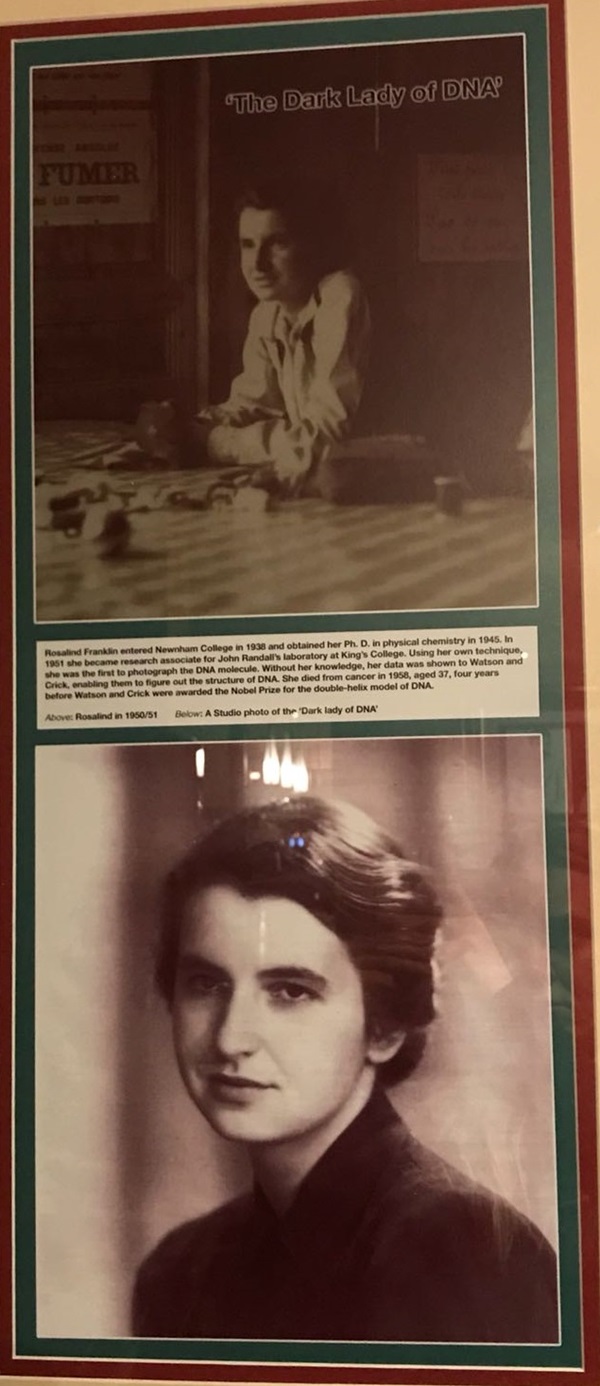
The text reads: Rosalind Franklin entered Newnham College in 1938 and obtained her Ph.D. in physical chemistry in 1945. In 1951 she became research associate for John Randall’s laboratory at King’s College. Using her own technique, she was the first to photograph the DNA molecule. Without her knowledge, her data was shown to Watson and Crick, enabling them to figure out the structure of DNA. She died from cancer in 1958, aged 37, four years before Watson and Crick were awarded the Nobel Prize for the double-helix model of DNA.
Above: Rosalind in 1950/51
Below: A studio photo of the ‘Dark lady of DNA’.
Prints and text about Watson and Crick.
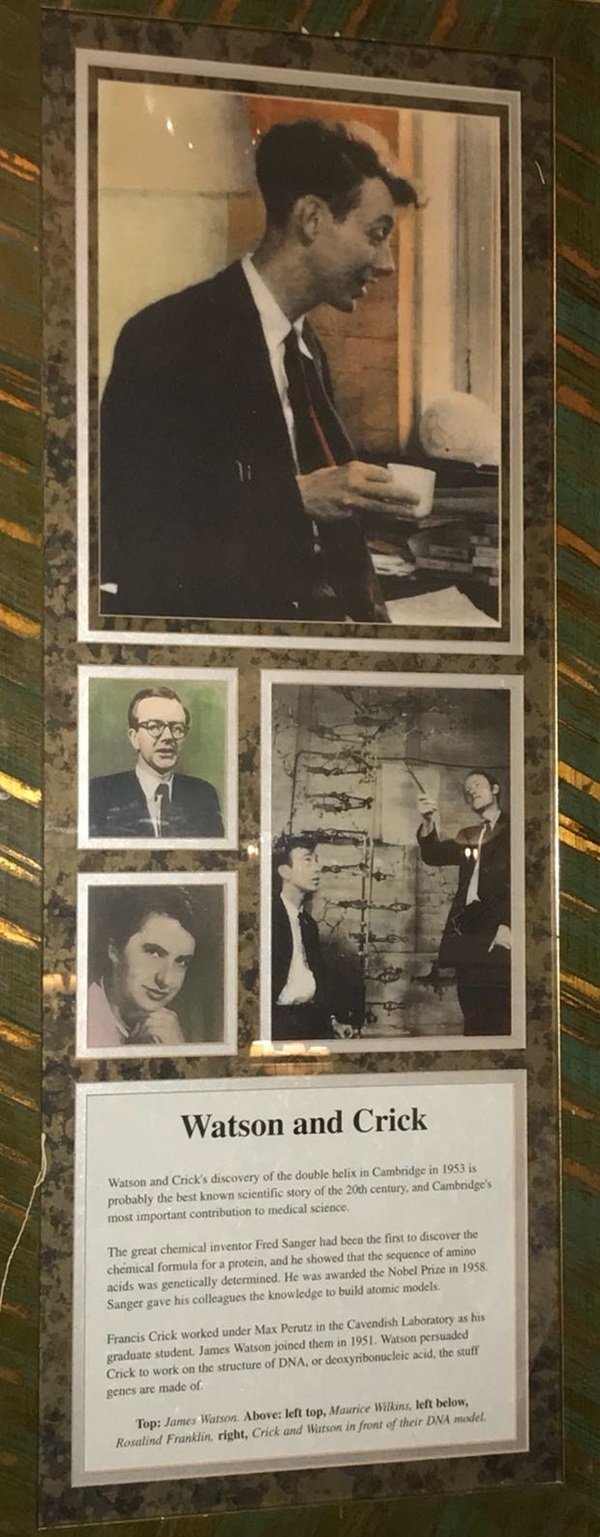
The text reads: Watson and Crick’s discovery of the double helix in Cambridge in 1953 is probably the best known scientific story of the 20th century, and Cambridge’s most important contribution to medical science.
The great chemical inventor Fred Sanger had been the first to discover the chemical formula for a protein, and he showed that the sequence of amino acids was genetically determined. He was awarded the Nobel Prize in 1958. Sanger gave his colleagues the knowledge to build atomic models.
Francis Crick worked under Max Perutz in the Cavendish Laboratory as his graduate student. James Watson joined them in 1951. Watson persuaded Crick to work on the structure of DNA, or deoxyribonucleic acid, the stuff genes are made of.
Top: James Watson
Above, left top: Maurice Wilkins
Left below: Rosalind Franklin
Right: Crick and Watson in front of their DNA model.
Photographs, illustrations and text about ‘The New River at Cambridge’.
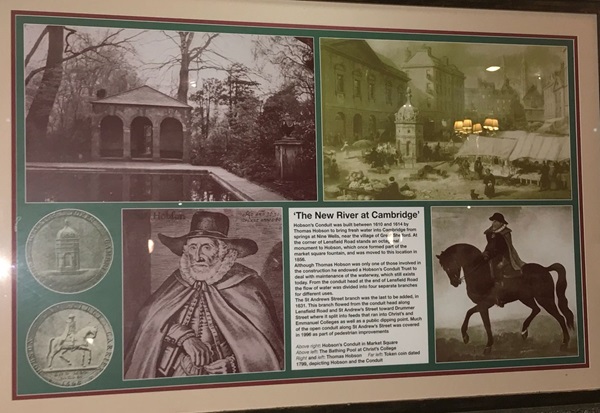
The text reads: Hobson’s Conduit was built between 1610 and 1614 by Thomas Hobson to bring fresh water into Cambridge from springs at Nine Wells, near the village of Great Shelford. At the corner of Lensfield Road stands an octagonal monument to Hobson, which once formed part of the market square fountain, and was moved to this location in 1856.
Although Thomas Hobson was only one of those involved in the construction he endowed a Hobson’s Conduit Trust to deal with maintenance of the waterway, which still exists today. From the conduit head at the end of Lensfield Road, the flow of water was divided into four separate branches for different uses.
The St Andrews Street branch was the last to be added, in 1631. This branch flowed from the conduit head along Lensfield Road and St Andrew’s Street toward Drummer Street where it split into feeds that ran into Christ’s Emmanuel Colleges as well as a public dipping point. Much of the open conduit along St Andrew’s Street was covered in 1996 as part of pedestrian improvements.
Above right: Hobson’s Conduit in Market Square
Above left: The Bathing Pool at Christ’s College
Right and Left: Thomas Hobson
Far left: Token coin dated 1799, depicting Hobson and the Conduit.
An illustration and text about the ancient game of football.
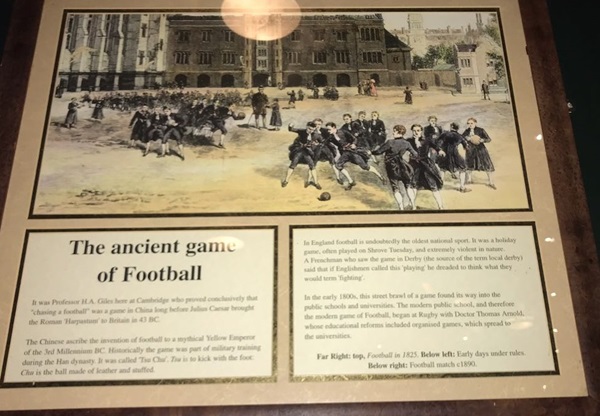
The text reads: It was Professor HA Giles here at Cambridge who proved conclusively that “chasing a football” was a game in China long before Julius Caesar brought the Roman ‘Harpastum’ to Britain in 43 BC.
The Chinese ascribe the invention of football to a mythical Yellow Emperor of the 3rd Millennium BC. Historically the game was part of military training during the Han dynasty. It was called ‘Tsu Chu’. Tsu is to kick with the foot: Chu is the ball made of leather and stuffed.
In England football is undoubtedly the oldest national sport. It was a holiday game, often played on Shrove Tuesday, and extremely violent in nature. A Frenchman who saw the game in Derby (the source of the term local derby) said that if Englishmen called this ‘playing’ he dreaded to think what they would term ‘fighting’.
In the early 1800s, this street brawl of a game found its way into the public schools and universities. The modern public school, and therefore the modern game of Football, began at Rugby with Doctor Thomas Arnold, whose educational reforms included organised games, which spread to the universities.
Far right, top: Football in 1825.
Below, left: Early days under rules.
Below, right: Football match, c1890.
Illustrations and text about Cambridge before the university.
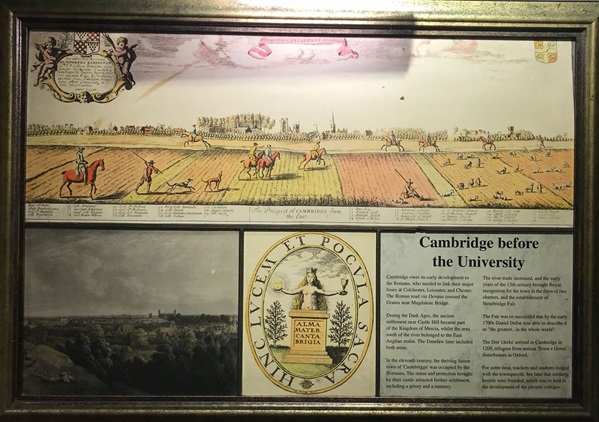
The text reads: Cambridge owes its early development to the Romans, who needed to link their major bases at Colchester, Leicester, and Chester. The Roman road via Devana crossed the Granta near Magdalene Bridge.
During the Dark Ages, the ancient settlement near Castle Hill became part of the Kingdom of Mercia, whilst the area south of the river belonged to the East Anglian realm. The Danelaw later included both areas.
In the eleventh century, the thriving Saxon town of ‘Cantebrigge’ was occupied by the Normans. The status and protection brought by their castle attracted further settlement, including a priory and a nunnery.
The river trade increased, and the early years of the 13th century brought Royal recognition for the town in the form of two charters, and the establishment of Stourbridge Fair.
The fair was so successful that by the early 1700s Daniel Defoe was able to describe it as “the greatest… in the whole world.”
The first ‘clerks’ arrived in Cambridge 1209, refugees from serious ‘Town v Gown’ disturbances in Oxford.
For some time, teachers and students lodged with the townspeople, but later that century hostels were founded, which was to lead to the development of the present colleges.
Photographs and text about the Cambridge Footlights.
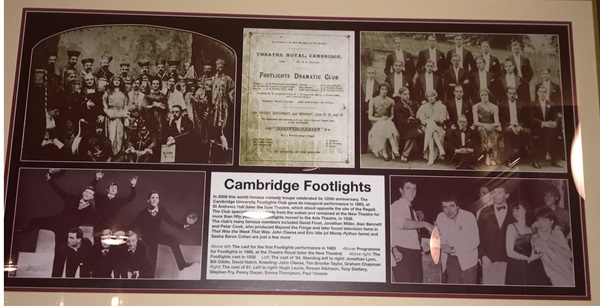
The text reads: In 2008 this world-famous comedy troupe celebrated its 125th anniversary. The Cambridge University Footlights Club gave its inaugural performance in 1883, at St Andrews Hall (later the New Theatre, which stood opposite the site of the Regal). The Club specialised in comedy from the outset and remained at the New Theatre for more than fifty years. The Footlights moved to the Arts Theatre, in 1936.
The club’s many famous members included David Frost, Jonathan Miller, Alan Bennett and Peter Cook, who produced Beyond the Fridge and later found television fame in The Was the Week That Was. John Cleese and Eric Idle (of Monty Python fame) and Sasha Baron Cohen are just a few more.
Above, left: The cast for the first Footlights performance in 1883
Above: Programme for Footlights in 1886, at the Theatre Royal (later the New Theatre)
Above, right: The Footlights cast in 1930
Left: The cast of ’64. Standing left to right: Jonathan Lynn, Bill Oddie, David Hatch. Kneeling: John Cleese, Tim Brooke-Taylor, Graham Chapman.
Right: The cast of ’81. Left to right: Hugh Laurie, Rowan Atkinson, Tony Slattery, Stephen Fry, Penny Dwyer, Emma Thompson, Paul Shearer.
Prints and text about Charles Darwin.
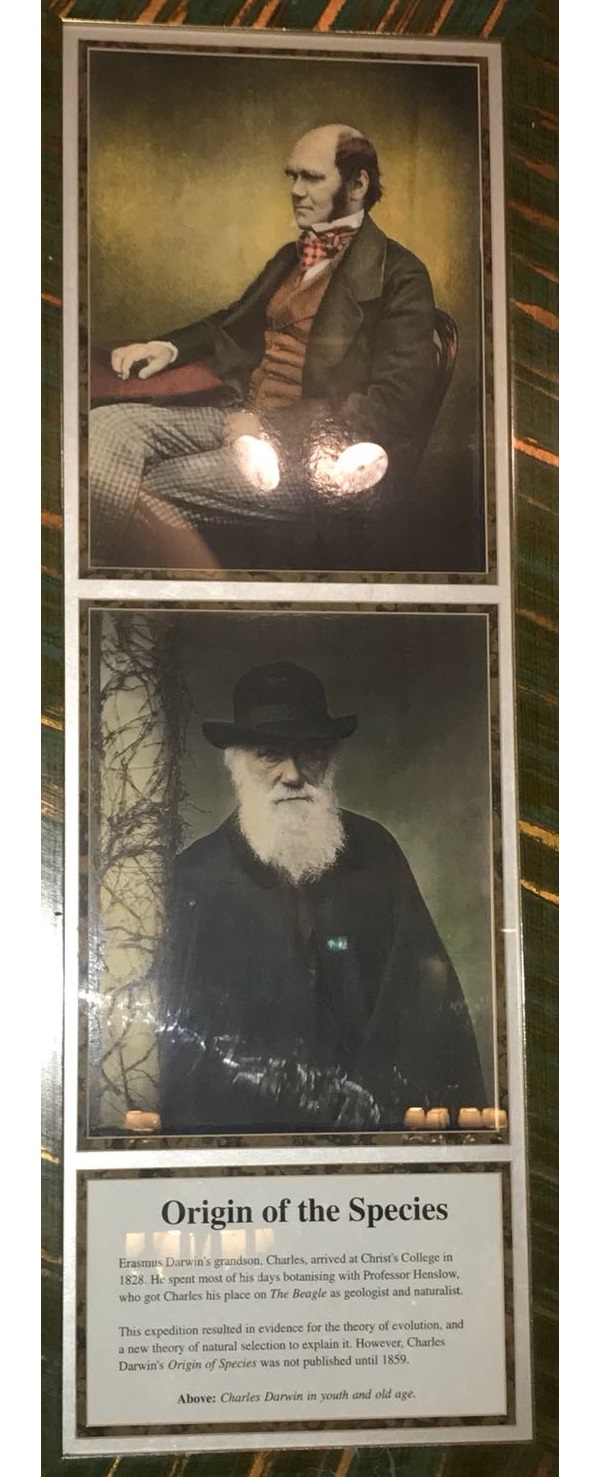
The text reads: Erasmus Darwin’s grandson, Charles, arrived at Christ’s College in 1828. He spent most of his days botanising with Professor Henslow, who got Charles his place on The Beagle as geologist and naturalist.
This expedition resulted in evidence for the theory of evolution, and a new theory of natural selection to explain it. However, Charles Darwin’s Origin of Species was not published until 1859.
Above: Charles Darwin in youth and old age.
Illustrations and text about TH Huxley - Darwin’s Bulldog.
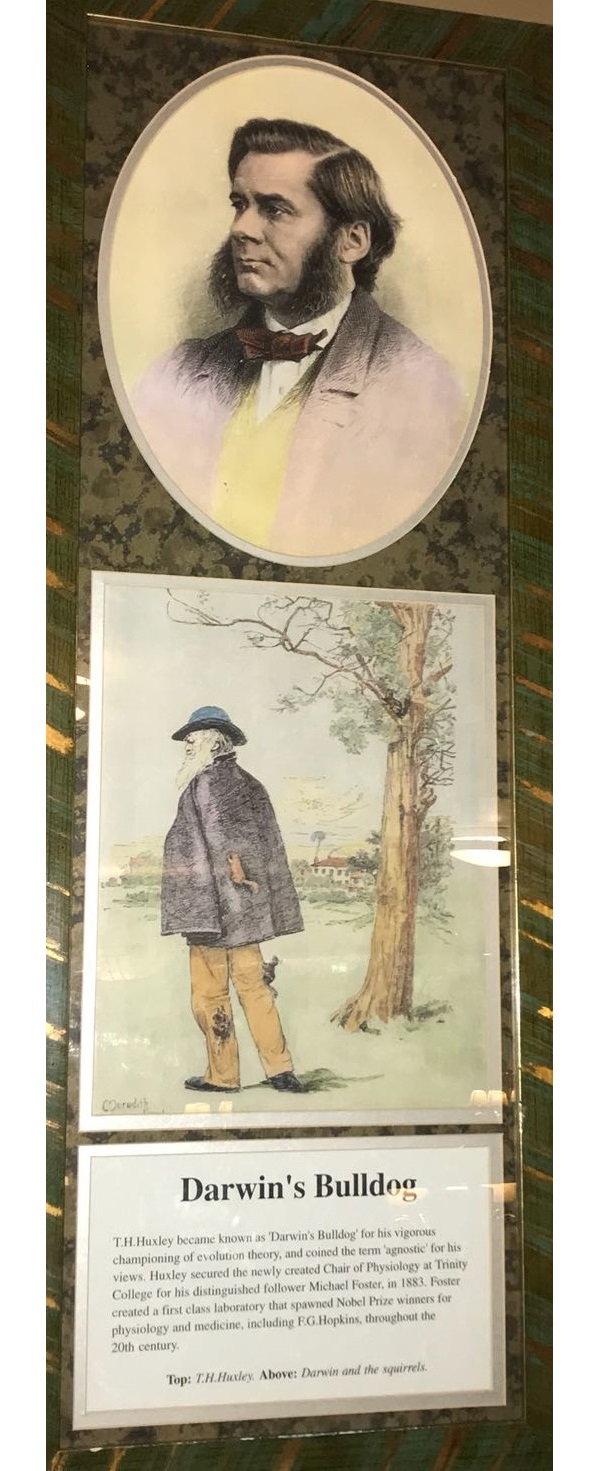
The text reads: TH Huxley became known as Darwin’s Bulldog for his vigorous championing of evolution theory, and coined the term ‘agnostic’ for his views. Huxley secured the newly created Chair of Physiology at Trinity College for his distinguished follower Michael Foster, in 1883. Foster created a first class laboratory that spawned Nobel Prize winners for physiology and medicine, including FG Hopkins, throughout the 20th century.
Top: TH Huxley
Above: Darwin and the squirrels.
Illustrations and text about Gulliver’s travels.
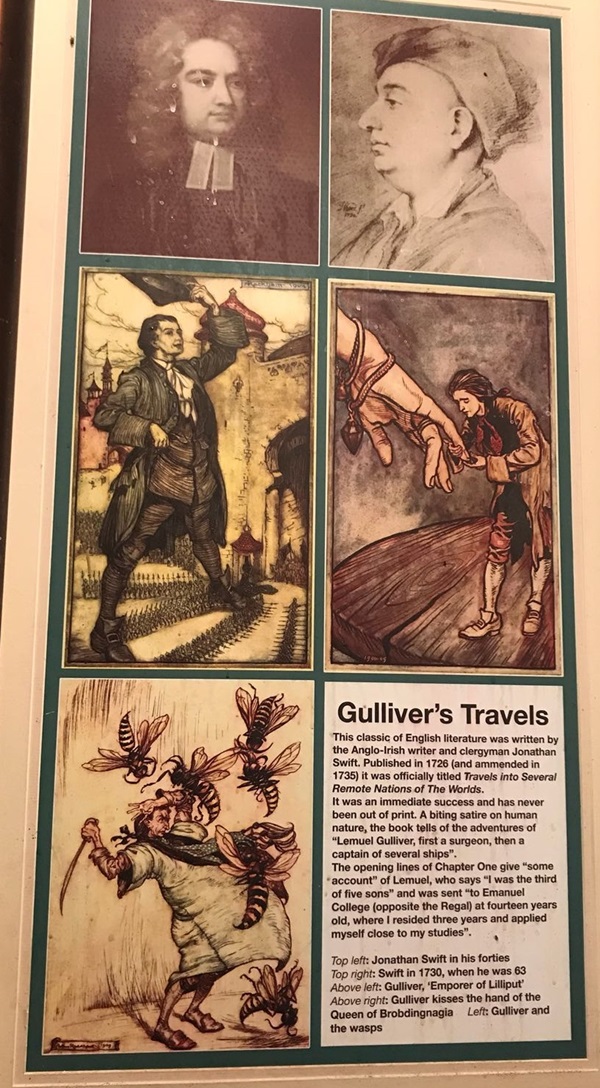
If you have information on the history of this pub, then we’d like you to share it with us. Please e-mail all information to: pubhistories@jdwetherspoon.co.uk